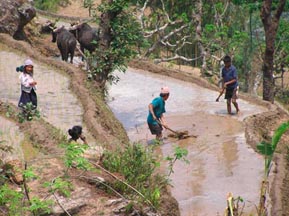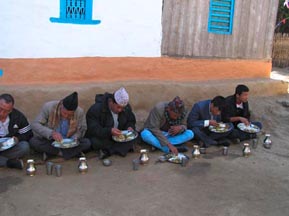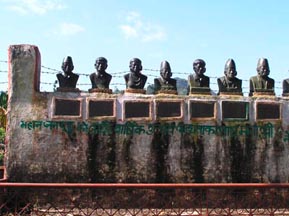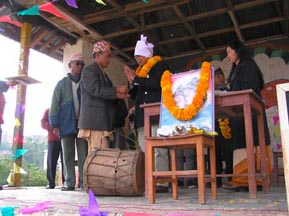The People of Chintang
The name Chintang above all refers to the village and VDC (village development committee) of Chintang which is located in Dhankuta District, at the lower end of a long ridge that extends from the Limbu area of Panchthar down to the confluence of the Arun and Tamor Koshi. Only recently has the name become an ethnic category, as it turned out that the original inhabitants of Chintang have a distinct Rai language. But in a localizing sense the adjectival term Chintange is applied to all residents of the village, including various other Rai (mainly Bantawa, but also Puma, Kulung, Thulung etc.) as well as Chetri or Kami. A closer look at history and social organisation shows that there are "original settlers", the Chintange proper, who have a disitinct language, and only in later times other Rai, especially Bantawa from the Bhojpur district (across the Arun river), have immigrated and settled alongside these Chintang. They have intermarried and often adopted the Chintang language as a first or at least second language, yet in terms of patilineal clans there is still a clear distinction between ethnic Chintange and localized Chintange. Altogether there are more than 50 Rai clans in the village district of Chintang!
The 13 clans of the original Chitang do not claim to have a common ancestor. This is a somewhat unusual situation, as many Rai groups have a mythic forefather, and the myths generally describe how his offspring settled and founded the different clans. According to local myth (in fact, different and loosely linked stories), the first forefathers who settled in present day's Chintang were Sambhoŋ, Chentaŋhaŋpa, Rahaŋba and Khɨkkhaŋ. Thus the Chintang clans are derived from no less than four different forefathers, but in the narratives it is not clear where the forefathers came from. They may well have come from different regions.
There is however one mythic ancestor, called Budhohang, who is an important figure in local thinking: Budhohang (along with Rajdeu) is worshiped on almost all major ritual celebrations. Budhahang is a kind of local hero, who fought against the Shah king, using magical powers which made him successful initially, though he was later vanquished and mysteriously disappeared. But the people believe that he is still alive and immortal. The story is consistent in some details about a son who was killed, and about another person (who was of Brahman descent) whom he adopted. It is possible that some of the elements of the story have a historical base.
Well known beyond the village is the temple of the goddess Chintang Devi (located in a sacred grove in ward No. 3). Many visitors from various groups (including high castes) come to visit on a pilgrimage. In fact, the temple is en route to the ancient pilgrimage site of Barahchetra (Varahaksetra) down at the confluence of the Seven Rivers (Sapta Kosi), and so it seems that since many generations Kirantis who travelled down to the Tarai walked along this major path.
Martin Gaenszle and Judith Pettigrew (in charge of ethnography for CPDP)



